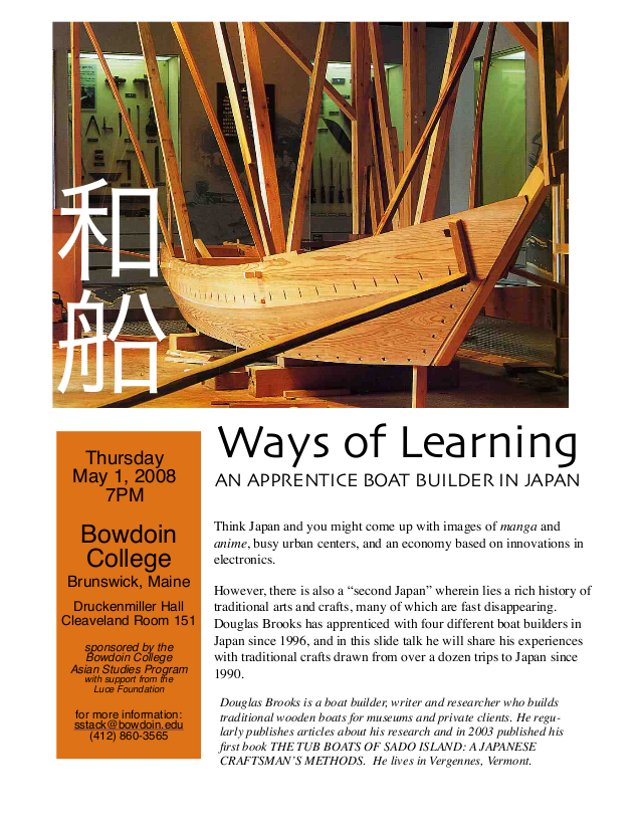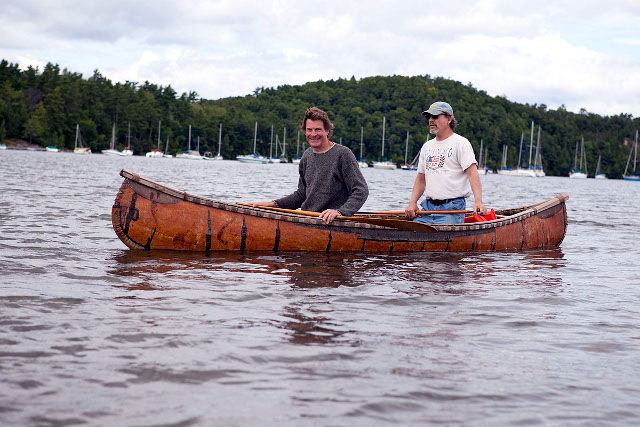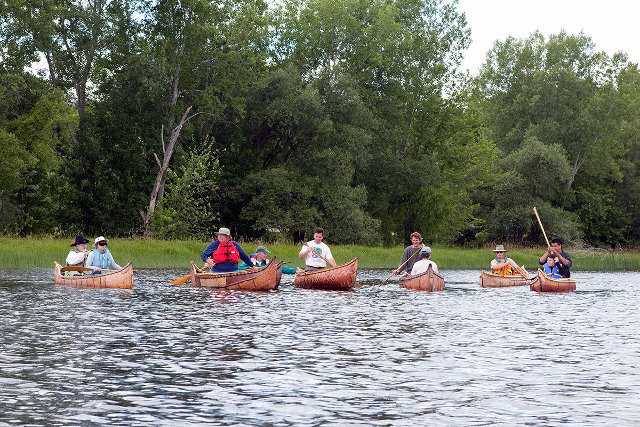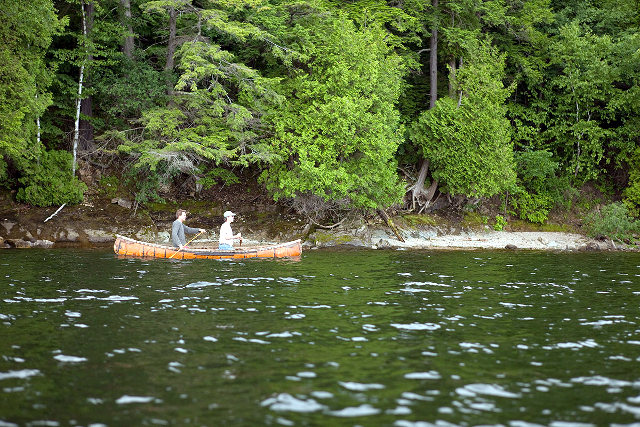Archives of various projects since 2007
Archives from previous years :: 2008 :: 2007
November 2009 - The Sabani Project
Douglas Brooks is in Lejima, Japan, apprenticing with a Japanese boatbuilder and his son building an eight meter sabani; a traditional wooden fishing boat. This is part of Brooks' on-going research and documentation of wasen - traditional boats of Japan. This is his fifth apprenticeship and will be included in an upcoming book about his research. He is writing a blog which will stand in until he can post more substantial material later on this web site.
September 2009:
One piece of news: my friend Marc Bauer has completed drawings lines and construction details for the Rushton catboat, a boat I wrote about here under the August, 2008 heading. But Marc has also published a short article about drawing the boat and its design, which you can read at: http://www.amateurboatbuilding.com/articles/design/bauer/catboat/index.html
The current boat I am working on is a St. Lawrence River Skiff, built to lines of the Sheldon skiff at Mystic Seaport. I am finishing the boat this fall and winter and hope to have it available for delivery next spring. She is planked entirely in Atlantic white cedar, perhaps the most prized small boat planking material in the norhteast. She will be framed in white oak or locust.
August 2009:
In mid-August I auditioned for the Vermont Humanities Council's Speakers Bureau, which is a selection of speakers on a wide variety of topics that is made available state-wide to libraries and other institutions. Institutions can apply for lecturers and receive support for these talks through the VHC. My talk on traditional Japanese boat building will now be advertised and hopefully this will give me the chance to speak at more venues throughout Vermont. I've given talks about my work for many years, usually at maritime museums and wooden boat shows, and more recently on college campuses. For the wooden boat crowd I naturally tend to focus on the ins and outs of Japanese boat building. For college audiences and the general public, I entitle my talk "Ways of Learning" and spend more time talking about the nature of craft apprenticeship in Japan, and how those traditions differ from those in the west. I realize that the way my teachers instructed me in Japan has a great deal in common with Buddhist training. But Vermont is also a rich and justly famous environment for craftspeople, many of whom came from away back in the 70's. Here we don't have an easily described tradition of craft apprenticeship, but I think that a description of my experiences in Japan can spark an interesting discussion here in Vermont about craft, craft education, and the loss and resurrection of these traditions. Visit the Vermont Humanities Council and learn more at: http://www.vermonthumanities.org/index.htm
And people love the poster that my wife designed for my talks.
July, 2009:
Earlier this month I went over to Maine to give a talk at the Carpenter's Boat Shop, a small and very unique boat building school in Pemaquid, near Damariscotta. I was originally scheduled to teach a week-long half model making/lofting workshop but we didn't get enough students. I had also offered to give my lecture on traditional Japanese boat building, and my wife and I decided that going over for two days and being hosted by the school would make a nice little vacation for us. The talk was well attended by a very knowledgeable and enthusiastic crowd (but of course, this was the coast of Maine). One attendee, Bob Holtzman, writes a blog called Indigenous Boats, and just recently he wrote to say that he had blogged about my talk, with some detail on the Japanese tub boat (my first apprenticeship) and, as one thing leads to another on the web, one of the comments to his blog post was a blogger from England, Gavin Atkin, who shared a very interesting link to the story of a man, a tub, and the ocean. Here are the links:
http://indigenousboats.blogspot.com/
http://www.visit1066country.com/Hastings/attractions/fishermens/biddy.aspx?
image=3#slideshow
And Mr. Atkins blog is: http://intheboatshed.net/
July 2009:
As someone whose work so often involves historic boats and boat building traditions, its not surprising that I decided to get involved with the Quadricentennial of Samuel de Champlain's discovery of Lake Champlain, which was a major event in this region in 2009. Past celebrations, in 1909 and 1959, had leaned heavily toward the reenactment theme, with the 1959 celebration featuring a gathering of two dozen birch bark canoes made especially for the event by the Maniwaki Reserve in Quebec. Three members of the tribe came to Vermont, and local young men were hired to "play Indian" while one distinguished looking man was dressed as Champlain, and this Canoecade, as it was called, traveled around the lake for three weeks.
This year's events featured art, music, drama, storytelling and parades, with few nods toward the historic event. Champlain had left Quebec in his shallop with a group of about a dozen men. When their European style boat could not pass the falls at Chambly on the Richilieu River, Champlain and two of his men joined the two dozen native canoes that his allies (primarily Algonquins) and continued on to the lake that now bears his name. He entered the lake on July 14, 1609 and I organized a flotilla of birch bark canoes for a paddle to Burlington for July 14, 1909. Ted Behne, a noted historian and builder of birch bark canoe models offered to invite canoeists, and locally we invited any recreational paddler or kayaker to join our event. In the end we had birch bark canoes from Maine to Michigan to Maniwaki. The latter canoe was built on the reserve by the grandson of the man who built the canoes in 1959. The canoes were displayed at Shelburne Farms the morning of the event. Our arrival in Burlington was greeted by over three hundred people who mobbed the canoes and their owners when they came out of the water. That evening the canoes were exhibited at ECHO, the Leahy Center for Lake Champlain.




May 2009:
I spoke this spring at Middlebury College, a talk that was sponsored by the Japanese Department. After the talk, I learned that a recent graduate had gone to Japan and enrolled at a school for bamboo crafts in Oita, Kyushu. He is Stephen Jensen and he was a Japanese/Studio Arts major at Middlebury. My one and only contact with the world of bamboo is through making the taketaga, or bamboo hoops, that hold together the tub boats that I learned to build on Sado Island. This is classic Japanese coopering. Interestingly, Mr. Jensen told me that no one at his school was familiar with the techniques of making bamboo hoops. The school is focused on bamboo basketry, a highly refined Japanese craft that is beautiful to behold. But Mr. Jensen took enthusiastically to my small corner of the bamboo world and would up writing a blog post about my work. It's in Japanese and is derived from my first book, The Tub Boats of Sado Island; A Japanese Craftsman's Methods, published in English and Japanese in 2003 by the Kodo Cultural Foundation. In Japan the book can be found at major bookstores, or directly from the publisher (www.kodo.or.jp). In Europe the easiest way to get a copy is to contact the German tool store DICK gmb (http://www.dick.biz:80/dick/product/713704/detail.jsf), in North America and the rest of the world it is best to buy it from me directly (where you can get a signed copy).
Anyway, Mr. Jensen's blog post can be found at:
http://bamboooita.blogspot.com/2009/05/blog-post.html
February 2009:
My friend Marc Bauer, a naval architect in California with whom I have worked, sent me plans for a little dory he designed for glued plywood construction. A good friend of mine here was thinking of building his first boat and I encouraged him to consider Marc's dory. I had a sense that in building the first boat we might discover some construction and design issues and that the experience would be a precious one for my friend, and that we'd generate some useful feedback for Marc. I started with Tom in showing him how to make a half model of the boat, and he was thrilled enough with that to want to start building the real thing. Rather than re-publish the whole thing here, I suggest you follow these links to where Marc's comments on the design are posted, as well as my write-up on making the model and the boat. Note: as of right now the dory is still unfinished, with more postings to come as we complete it.
http://www.amateurboatbuilding.com/articles/design/bauer/dory/index.html
http://www.amateurboatbuilding.com/articles/howto/half_model/index.html
http://www.amateurboatbuilding.com/articles/building/bauer_dory/index.html
© Copyright Douglas Brooks, 2007 - 2018. All rights reserved
